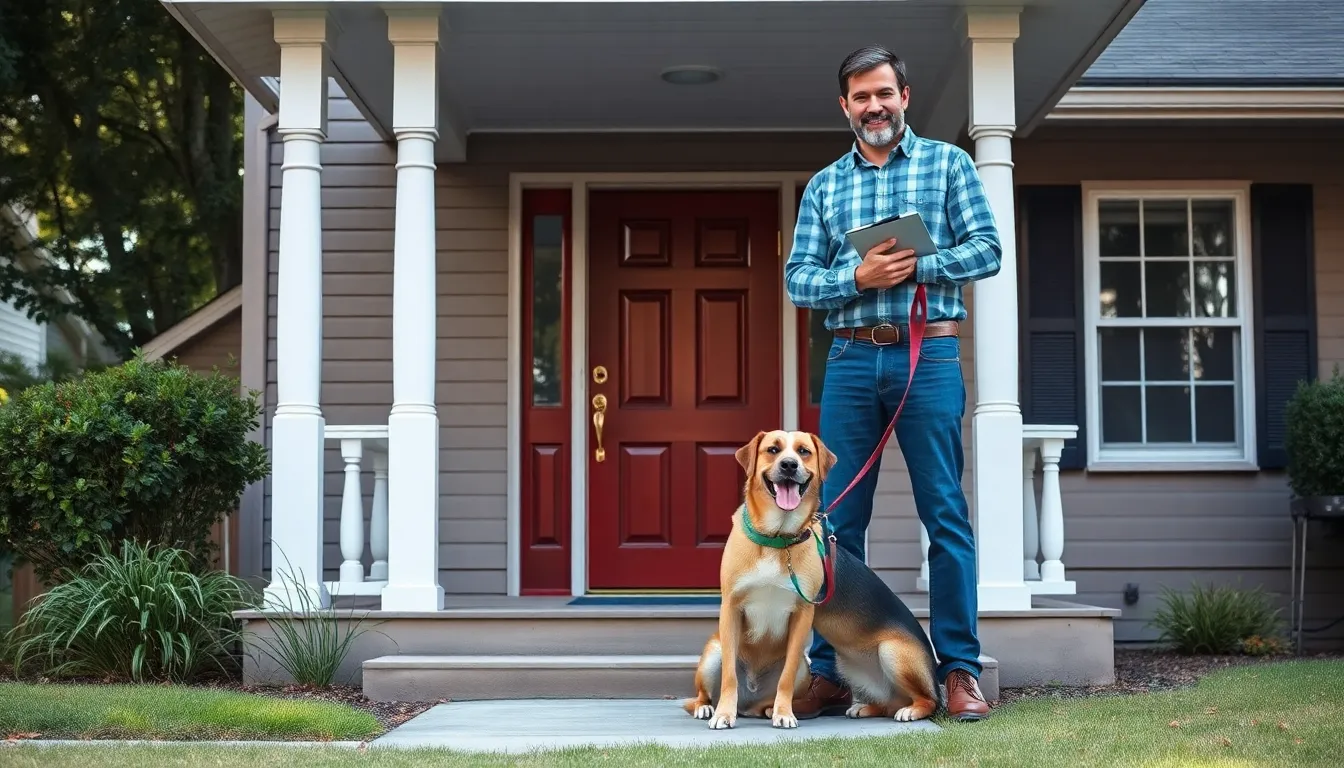In today’s rental market, pet ownership is on the rise, prompting landlords to reevaluate their pet policies. Many tenants view their furry companions as family members, making pet-friendly housing increasingly desirable. However, landlords often grapple with the challenges of accommodating pets while protecting their properties and maintaining a harmonious living environment.
Understanding landlord pet policies is crucial for both property owners and renters. These policies can vary widely, from outright bans to specific breed restrictions and pet deposits. By navigating this complex landscape, landlords can attract responsible pet owners while ensuring their properties remain safe and well-maintained. This article delves into the key aspects of landlord pet policies, offering insights for both parties involved in the rental process.
Table of Contents
ToggleOverview of Landlord Pet Policies
Landlord pet policies vary significantly, reflecting individual preferences and property types. Many landlords choose to impose restrictions to protect their investments while considering tenant needs. Common policy types include:
- Pet Restrictions: Some landlords prohibit pets entirely, often due to concerns about property damage or noise disturbances.
- Breed and Size Restrictions: Certain landlords allow pets but limit specific breeds deemed aggressive or restrict pet size, ensuring compatibility with property conditions.
- Pet Deposits: Many landlords require non-refundable or refundable deposits to cover potential damages caused by pets. These deposits typically range from $200 to $500.
- Pet Fees: Additional monthly fees may apply, often used to offset maintenance costs associated with pet-friendly properties. These fees can vary between $25 and $75.
- Pet Agreements: Landlords often require tenants to sign documents detailing responsibilities regarding pet care, waste disposal, and noise management.
Understanding these policies enhances tenant-landlord relationships, fostering a smoother rental experience. Both parties benefit from clear communication that addresses concerns while accommodating pet ownership.
Importance of Pet Policies for Landlords

Pet policies play a crucial role for landlords in the current rental market, where pet ownership is increasingly common. Establishing clear policies helps maintain property standards while accommodating pet owners.
Legal Considerations
Landlords must adhere to local laws and regulations regarding pet ownership in rental properties. Many jurisdictions enforce fair housing laws that prohibit discrimination against tenants with disabilities who require assistance animals. It’s essential to review these laws to avoid potential legal repercussions. Additionally, pet policies should specify breed restrictions and weight limits to mitigate liability risks. Drafting comprehensive pet agreements can further provide legal protection by outlining tenant responsibilities, thereby minimizing misunderstandings.
Risk Management
Managing risks associated with pet policies is vital for landlords. Allowing pets can lead to property damage, noise complaints, or liability from injuries caused by animals. Implementing pet deposits ranging from $200 to $500, along with monthly pet fees of $25 to $75, can help cover potential damages. Additionally, requiring tenants to carry renters insurance that includes pet liability coverage further safeguards the property owner’s interests. Establishing screening criteria for pets ensures responsible ownership, reducing risks associated with allowing pets on the premises.
Common Pet Policy Provisions
Landlord pet policies typically include specific provisions that address various aspects of pet ownership in rental properties. Understanding these provisions helps both landlords and tenants navigate their rights and responsibilities effectively.
Breed and Size Restrictions
Landlords often implement breed and size restrictions to minimize risks associated with certain dog breeds deemed aggressive or unsuitable for residential environments. Common restrictions include limitations on breeds like Pit Bulls, Rottweilers, and Doberman Pinschers. Size limits usually cap dogs at weights ranging from 25 to 50 pounds. These restrictions aim to ensure safety and comfort for all tenants while maintaining property standards.
Pet Deposits and Fees
Landlords frequently require pet deposits and fees as a safeguard against potential damages. Deposit amounts typically range from $200 to $500, depending on the property and type of pets allowed. Some landlords opt for non-refundable deposits, while others return the deposit after a satisfactory inspection. In addition to deposits, landlords may assess monthly pet fees that range from $25 to $75. These fees help cover maintenance and cleaning costs associated with pet ownership, establishing a fair balance between accommodating pets and protecting the property’s condition.
Impact on Tenants and Their Pets
Landlord pet policies significantly influence tenant experiences and pet ownership in rental properties. These policies shape tenant satisfaction and affect market dynamics for pet-friendly rentals.
Tenant Satisfaction
Tenant satisfaction often hinges on the pet policies implemented by landlords. When policies accommodate pets, tenants experience higher levels of happiness and stability in their living arrangements. A survey by the American Apartment Owners Association indicates that 72% of pet owners find pet-friendly policies appealing. Clear pet policies help foster a sense of belonging, contributing to longer lease durations. Furthermore, tenants feel more supported when policies explain responsibilities related to pet ownership, such as noise control and cleaning protocols.
Market Demand for Pet-Friendly Rentals
Market demand for pet-friendly rentals continues to rise, reflecting changing societal attitudes towards pet ownership. According to a 2021 report by Zillow, nearly 70% of renters prefer properties that accommodate pets. Properties with flexible pet policies attract a larger pool of prospective tenants, increasing occupancy rates. Additionally, pet-friendly units often command higher rents, with some landlords charging an extra $50 per month. As pet ownership grows, landlords recognizing this trend can position themselves competitively in the rental market by implementing inclusive policies that cater to pet owners.
Challenges in Implementing Pet Policies
Implementing pet policies poses several challenges for landlords. The need to balance tenant rights with property protection and community dynamics complicates these decisions.
Managing Complaints and Damages
Landlords face difficulties managing tenant complaints and potential property damages associated with pets. Pets may create noise disturbances, leading to grievances from non-pet-owning tenants. It’s essential for landlords to establish clear communication channels for addressing complaints promptly. Additionally, landlords often encounter costs related to property damage, such as scratched floors or stained carpets, necessitating regular inspections. Implementing proactive measures, such as requiring security deposits and comprehensive pet agreements, can mitigate these risks. A structured approach to inspections and maintenance can also help manage both tenant satisfaction and property integrity.
Balancing Interests of Non-Pet Owners
Balancing the interests of non-pet owners presents a significant challenge. Non-pet owners may have concerns about allergies, cleanliness, and disturbances caused by pets. Landlords can implement policies that address these issues, such as limiting the number of pets per unit or designating specific areas for pet use. Establishing guidelines for pet behavior and maintenance can also alleviate concerns. Open dialogue between landlords and tenants helps tailor policies that accommodate pet owners while respecting the preferences of non-pet owners, ultimately fostering a harmonious living environment.
Navigating landlord pet policies requires careful consideration from both landlords and tenants. As pet ownership continues to rise, understanding these policies is crucial for creating a harmonious living environment. Clear communication and well-defined agreements can significantly enhance tenant satisfaction while protecting property interests.
Landlords who embrace flexible pet policies may find themselves attracting a larger pool of potential renters and fostering longer lease durations. By balancing the needs of pet owners with the concerns of non-pet owners, landlords can create a community that values both safety and companionship. Adapting to the evolving rental market will not only benefit landlords but also contribute to a more positive tenant experience.



